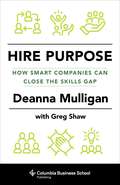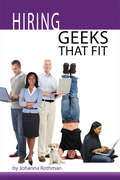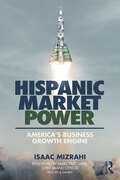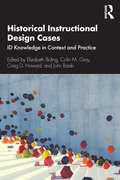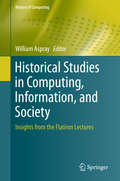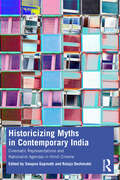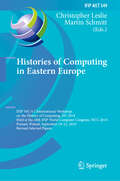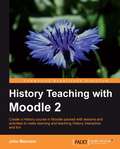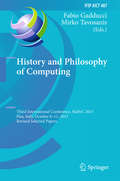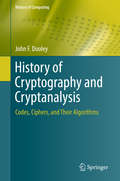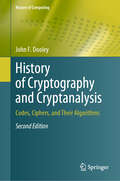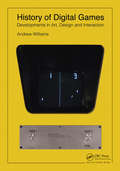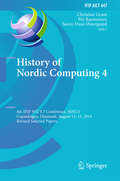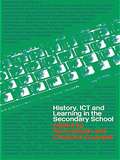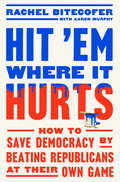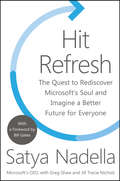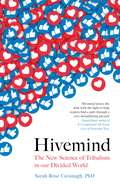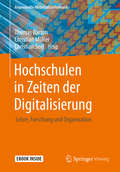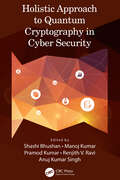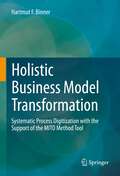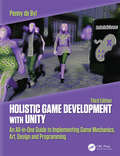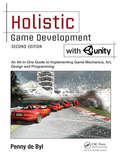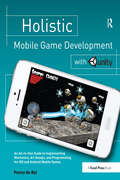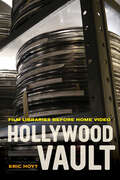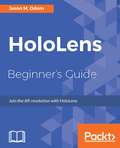- Table View
- List View
Hire Purpose: How Smart Companies Can Close the Skills Gap
by Greg Shaw Deanna MulliganThe future of work is already here, and what this future looks like must be a pressing concern for the current generation of leaders in both the private and public sectors. In the next ten to fifteen years, rapid change in a post-pandemic world and emerging technology will revolutionize nearly every job, eliminate some, and create new forms of work that we have yet to imagine. How can we survive and thrive in the face of such drastic change?Deanna Mulligan offers a practical, broad-minded look at the effects of workplace evolution and automation and why the private sector needs to lead the charge in shaping a values-based response. With a focus on the power of education, Mulligan proposes that the solutions to workforce upheaval lie in reskilling and retraining for individuals and companies adapting to rapid change. By creating lifelong learning opportunities that break down boundaries between the classroom and the workplace, businesses can foster personal and career well-being and growth for their employees. Drawing on her own experiences, historical examples, and reports from the frontiers where these issues are unfolding, Mulligan details how business leaders can prepare for and respond to technological disruption. Providing a framework for concrete and meaningful action, Hire Purpose is an essential read about the transformations that will shape the next decade and beyond.
Hiring Geeks That Fit
by Johanna Rothman"Do you want to hire great people? Not sure how? Read this book.Knowledge workers -- your geeks -- are different from skill-based staff. So, you should hire them differently. You need to analyze your situation, determine the problems you have, understand your culture, and then you can hire the right kinds of people.Cultural fit is critical, because we rarely fire people based on technical skill. But we frequently fire them because of that elusive fit. And, that's an expensive proposition.Hiring great geeks forces you to recognize and match culture, non-technical qualities, preferences and skills, and finally, technical skills. These people will adapt their knowledge to your specific situation, the context. They are the sum of both what they know and how they apply that knowledge to the product.As a result, one developer, tester, or technical manager is not interchangeable with another. This makes hiring technical people one of the most critical and difficult processes a technical manager or team can undertake.Hiring Geeks That Fit takes the guesswork out of hiring and reduces the risk of costly hiring mistakes. You'll learn how to:Develop a hiring strategy so you know how to solve your problemAnalyze the job, so the job description and ad falls out of the analysisI Source candidates, using a variety of approaches including LinkedIn and TwitterDevelop effective ads for different mediumsReview resumes quickly to determine Yes, No, or Maybe candidatesDevelop behavior-description questions and auditionsCreate phone screens that help you know who to bring in for an in-person interviewMake the most of an in-person interviewCheck referencesExtend an offer that will attract a win-win acceptance or tender a gentle-but-decisive rejectionCreate a great first day experience for new hiresLearn how to create a buddy system to decrease the cost of a new hireWhat to do if you can't find someoneYou, your team, and your organization will live with the long-term consequences of your hiring decision. Investing the time for you and your team in how to hire and interview will pay off fast.This book was written and produced entirely by the author. We are proud to be distributing it."
Hispanic Market Power: America’s Business Growth Engine
by Isaac MizrahiThe US Hispanic segment represents the most prominent demographic growth in the country, and a huge and untapped business opportunity for companies willing to move away from preconceived notions and market effectively to Hispanic customers. This book shows you how. Now more than ever, corporations operating in the US should see the Hispanic population at the core of their existing and future strategies, but many leaders believe Hispanic marketing is the same marketing you run for Anglos but translated into Spanish, or that all Hispanics are undocumented immigrants with no purchasing power, or that using Mariachis in their communications is the way to connect with this diverse segment. It’s time for a modern approach, and in this book, Isaac Mizrahi, one of the country’s leading voices in multicultural marketing, uses his unique experience as a corporate executive, agency CEO, and industry leader to help businesses grow by leveraging the booming Hispanic consumer segment to drive sales. Filled with straightforward talk, illustrative case studies, and pragmatic suggestions and recommendations, this book counterbalances academic books on the topic with little connection to day-to-day reality and other books with a more political standpoint. This is a business book created by a marketer for other marketers and business leaders looking to succeed in the US.
Historical Instructional Design Cases: ID Knowledge in Context and Practice
by Elizabeth Boling Colin M. Gray Craig D. Howard John BaakiHistorical Instructional Design Cases presents a collection of design cases which are historical precedents for the field with utility for practicing designers and implications for contemporary design and delivery. Featuring concrete and detailed views of instructional design materials, programs, and environments, this book’s unique curatorial approach situates these cases in the field’s broader timeline while facilitating readings from a variety of perspectives and stages of design work. Students, faculty, and researchers will be prepared to build their lexicon of observed designs, understand the real-world outcomes of theory application, and develop cases that are fully accessible to future generations and contexts.
Historical Studies in Computing, Information, and Society: Insights from the Flatiron Lectures (History of Computing)
by William AsprayThis is a volume of chapters on the historical study of information, computing, and society written by seven of the most senior, distinguished members of the History of Computing field. These are edited, expanded versions of papers presented in a distinguished lecture series in 2018 at the University of Colorado Boulder – in the shadow of the Flatirons, the front range of the Rocky Mountains. Topics range widely across the history of computing. They include the digitalization of computer and communication technologies, gender history of computing, the history of data science, incentives for innovation in the computing field, labor history of computing, and the process of standardization. Authors were given wide latitude to write on a topic of their own choice, so long as the result is an exemplary article that represents the highest level of scholarship in the field, producing articles that scholars in the field will still look to read twenty years from now. The intention is to publish articles of general interest, well situated in the research literature, well grounded in source material, and well-polished pieces of writing. The volume is primarily of interest to historians of computing, but individual articles will be of interest to scholars in media studies, communication, computer science, cognitive science, general and technology history, and business.
Historicizing Myths in Contemporary India: Cinematic Representations and Nationalist Agendas in Hindi Cinema
by Swapna Gopinath Rutuja DeshmukhThis book examines cinematic practices in Bollywood as narratives that assist in shaping the imagination of the age, especially in contemporary India. It examines historical films released in India since the new millennium and analyses cinema as a reflection of the changing socio-political and economic conditions at any given period. The chapters in Historicizing Myths in Contemporary India: Cinematic Representations and Nationalist Agendas in Hindi Cinemas also illuminate different perspectives on how cinematic historical representations follow political patterns and market compulsions, giving precedence to a certain past over the other, creating a narrative suited for the dominant narrative of the present. From Mughal-e-Azam to Padmaavat, and Bajirao Mastani to Raazi, the chapters show how creating history out of myths validate hegemonic identities in a rapidly evolving Indian society. The volume will be of interest to scholars of film and media studies, literature and culture studies, and South Asian studies.
Histories of Computing in Eastern Europe: IFIP WG 9.7 International Workshop on the History of Computing, HC 2018, Held at the 24th IFIP World Computer Congress, WCC 2018, Poznań, Poland, September 19–21, 2018, Revised Selected Papers (IFIP Advances in Information and Communication Technology #549)
by Christopher Leslie Martin SchmittThis book consitutes the refereed post-conference proceedings of the IFIP WG 9.7 International Workshop on the History of Computing, HC 2018, Held at the 24th IFIP World Computer Congress, WCC 2018, in Poznań, Poland, in September 2018.The 16 revised full papers were carefully reviewed and selected from 20 submissions. They reflect academic approaches to history along with the expertise of museum and other public history professionals as well as the experience of computingand information science practitioners. The papers are organized in the following sections: Eastern Europe, Poland, Soviet Union, CoCom and Comecon; analog computing, and public history.
History Teaching with Moodle 2
by John MannionFollow the creation of a History course with lots of practical examples and screenshots. Each chapter builds on the course and takes you through a different aspect of teaching history using Moodle. All exercises in the book relate to different periods of history and are suitable for all students of high-school age.This book is for history teachers who would like to enhance their lessons using Moodle. It doesn't matter if you haven't used Moodle before; as long as someone has set it up for you, you can get started with the exercises in the book straightaway.
History and Philosophy of Computing
by Fabio Gadducci Mirko TavosanisThis volume constitutes the refereed post-conference proceedings of the Third International Conference on the History and Philosophy of Computing, held in Pisa, Italy in October 2015. The 18 full papers included in this volume were carefully reviewed and selected from the 30 papers presented at the conference. They cover topics ranging from the world history of computing to the role of computing in the humanities and the arts.
History of Cryptography and Cryptanalysis: Codes, Ciphers, and Their Algorithms (History of Computing)
by John F. DooleyThis accessible textbook presents a fascinating review of cryptography and cryptanalysis across history. The text relates the earliest use of the monoalphabetic cipher in the ancient world, the development of the “unbreakable” Vigenère cipher, and an account of how cryptology entered the arsenal of military intelligence during the American Revolutionary War. Moving on to the American Civil War, the book explains how the Union solved the Vigenère ciphers used by the Confederates, before investigating the development of cipher machines throughout World War I and II. This is then followed by an exploration of cryptology in the computer age, from public-key cryptography and web security, to criminal cyber-attacks and cyber-warfare. Looking to the future, the role of cryptography in the Internet of Things is also discussed, along with the potential impact of quantum computing.Topics and features: presents a history of cryptology from ancient Rome to the present day, with a focus on cryptology in the 20th and 21st centuries; reviews the different types of cryptographic algorithms used to create secret messages, and the various methods for breaking such secret messages; provides engaging examples throughout the book illustrating the use of cryptographic algorithms in different historical periods; describes the notable contributions to cryptology of Herbert Yardley, William and Elizebeth Smith Friedman, Lester Hill, Agnes Meyer Driscoll, and Claude Shannon; concludes with a review of tantalizing unsolved mysteries in cryptology, such as the Voynich Manuscript, the Beale Ciphers, and the Kryptos sculpture.This engaging work is ideal as both a primary text for courses on the history of cryptology, and as a supplementary text for advanced undergraduate courses on computer security. No prior background in mathematics is assumed, beyond what would be encountered in an introductory course on discrete mathematics.
History of Cryptography and Cryptanalysis: Codes, Ciphers, and Their Algorithms (History of Computing)
by John F. DooleyThis textbook presents a fascinating review of cryptography and cryptanalysis, from the earliest known cryptographic systems of 2,500 years ago up to modern computer-based systems. The text relates the earliest use of the monoalphabetic cipher in the ancient world, the development of the “unbreakable” Vigenère cipher, and an account of how cryptology entered the arsenal of military intelligence during the American Revolutionary War. Moving on to the American Civil War, the book explains the solution of the Vigenère ciphers used by the Confederates and the use of telegraph codes, before investigating the development of cipher machines throughout World War I and II, including development of the first digital computer, Colossus. The exposition then explores cryptology in the computer age, from public-key cryptography and web security to criminal cyber-attacks and cyber-warfare. The role of cryptography in the Internet of Things is also discussed, along with the potential impact of quantum computing. Topics and features: Presents a history of cryptology from ancient Rome to the present day, with a focus on cryptology in the 20th and 21st centuries Provides engaging examples illustrating use of cryptographic algorithms in different historical periods Reviews algorithms and devices used to create secret messages, and the various methods for breaking such messages Describes notable contributions to cryptology by Herbert Yardley, William and Elizebeth Smith Friedman, Lester Hill, Agnes Meyer Driscoll, and Claude Shannon Examines unsolved mysteries in cryptology, such as the Voynich Manuscript, the Beale Ciphers, the Kryptos sculpture, and the Zodiac killer ciphers This engaging work is ideal as both a primary text for courses on the history of cryptology, and as a supplementary text for advanced undergraduate courses on cryptology and computer security. No prior background in mathematics is assumed, beyond what would be encountered in an introductory course on discrete mathematics.
History of Digital Games: Developments in Art, Design and Interaction
by Andrew WilliamsThe growth of videogame design programs in higher education and explosion of amateur game development has created a need for a deeper understanding of game history that addresses not only "when," but "how" and "why." Andrew Williams takes the first step in creating a comprehensive survey on the history of digital games as commercial products and artistic forms in a textbook appropriate for university instruction. History of Digital Games adopts a unique approach and scope that traces the interrelated concepts of game design, art and design of input devices from the beginnings of coin-operated amusement in the late 1800s to the independent games of unconventional creators in the present. Rooted in the concept of videogames as designed objects, Williams investigates the sources that inspired specific game developers as well as establishing the historical, cultural, economic and technological contexts that helped shape larger design trends
History of Nordic Computing 4
by Christian Gram Per Rasmussen Søren Duus ØstergaardThis book constitutes the refereed post-proceedings of the 4th IFIP WG 9. 7 Conference on the History of Nordic Computing, HiNC 4, held in Copenhagen, Denmark, in August 2014. The 37 revised full papers were carefully reviewed and selected for inclusion in this volume. The papers focus on innovative ICT milestones that transformed the nordic societies and on the new ideas, systems and solutions that helped creating the welfare societies of today, in particular solutions and systems for public services, e. g. , tax, social benefits, health care and education; solutions and systems for the infrastructure of the society, e. g. , banking, insurance, telephones, transport and energy supply; and technologies and IT policies behind the major IT milestones, e. g. , user centric innovation, programming techniques and IT ethics. They are organized in topical sections on IT policy, infrastructure, public services, private services, telesystems, health care, IT in banking, transport and IT technology.
History, ICT and Learning in the Secondary School
by Christine Counsell Terry HaydnThis book explores the current use and potential of ICT in the secondary history curriculum, and offers sound theory and practical advice to help secondary history teachers use ICT effectively. Key areas covered include: getting started in ICT and history short, medium and long-term planning using ICT to develop historical understanding and skills data handling in the history classroom ICT and maps integrating virtual resources with the real world of teaching and learning. With contributions from leading academics and practitioners in history education, this book will be important reading for all secondary history teachers and trainee teachers, but will be of interest to upper primary school teachers too.
Hit 'Em Where It Hurts: How to Save Democracy by Beating Republicans at Their Own Game
by Rachel BitecoferA radical, urgent plan for how the Democratic Party and its supporters can win elections at one of the most pivotal moments in the history of our nation&’s democracy&“Bitecofer hits hard against the GOP tactics of fear and anger and the Democrats&’ status quo narratives around political engagement and winning elections.&”—Michael Steele, former RNC chairWhy do Democrats fail to win voters to their side, and what can they do to develop new winning political strategies—especially as the very fate of democracy hangs in the balance in 2024? Too often the carefully constructed, rational arguments of the Left meet a grisly fate at the polls, where voters are instead swayed by Republican candidates hawking anger, fear, and resentment. Only when Democrats are handed an overwhelming motivational issue—like the Supreme Court&’s 2022 Dobbs decision overturning Roe v. Wade—have they found a way to counter this effect.Political scientist and strategist Rachel Bitecofer came to prominence after predicting the size (to the seat) of the Democrats&’ rare Blue Wave in the 2018 midterms. At the heart of her prediction lay a powerful concept—negative partisanship, or the idea that voters, even most so-called independents, don&’t vote for their candidate so much as they vote against their candidate&’s opponent. Seen through this lens, Hit &’Em Where It Hurts is a deep dive into the Republicans&’ own playbook, sharing how Democrats can turn the Right&’s own tactics against them. The way for Democrats to wage—and win—electoral war, Bitecofer writes, is to present themselves as &“brand ambassadors for freedom, health, wealth, safety, and common sense,&” the very opposite of the extremist, freedom-fearing Right. This is a last-ditch effort to armor democracy while there is still time to save and strengthen it against hijacking by a small minority of ideologues.As America careens into the election cycle that will determine its democratic future, Hit &’Em Where It Hurts is the book for any Democrat who has ever banged their head against a wall when obvious reasoning failed to sway voters over to their side. This guide is a lifeline to save American democracy in its darkest hour.
Hit Refresh: The Quest to Rediscover Microsoft's Soul and Imagine a Better Future for Everyone
by Satya Nadella Greg Shaw Jill Tracie Nichols“At the core, Hit Refresh, is about us humans and the unique quality we call empathy, which will become ever more valuable in a world where the torrent of technology will disrupt the status quo like never before.” – Satya Nadella from Hit Refresh“Satya has charted a course for making the most of the opportunities created by technology while also facing up to the hard questions.” – Bill Gates from the Foreword of Hit Refresh The New York Times bestseller Hit Refresh is about individual change, about the transformation happening inside of Microsoft and the technology that will soon impact all of our lives—the arrival of the most exciting and disruptive wave of technology humankind has experienced: artificial intelligence, mixed reality, and quantum computing. It’s about how people, organizations, and societies can and must transform and “hit refresh” in their persistent quest for new energy, new ideas, and continued relevance and renewal. Microsoft’s CEO tells the inside story of the company’s continuing transformation, tracing his own personal journey from a childhood in India to leading some of the most significant technological changes in the digital era. Satya Nadella explores a fascinating childhood before immigrating to the U.S. and how he learned to lead along the way. He then shares his meditations as a sitting CEO—one who is mostly unknown following the brainy Bill Gates and energetic Steve Ballmer. He tells the inside story of how a company rediscovered its soul—transforming everything from culture to their fiercely competitive landscape and industry partnerships. As much a humanist as engineer and executive, Nadella concludes with his vision for the coming wave of technology and by exploring the potential impact to society and delivering call to action for world leaders. “Ideas excite me,” Nadella explains. “Empathy grounds and centers me.” Hit Refresh is a set of reflections, meditations, and recommendations presented as algorithms from a principled, deliberative leader searching for improvement—for himself, for a storied company, and for society.
Hivemind: The New Science of Tribalism in Our Divided World
by Sarah Rose CavanaghCavanagh brings you along on her journey through an exquisite collection of scholarly knowledge and empirical insight to ground both your mind and your gut. From zombies to bees, moral panics to conspiracy theories, Hivemind mixes the dark with the light to help readers find a path through a very destabilizing present' - Danah Boyd, author of It's Complicated: The Social Lives of Networked Teens'This fascinating book guides us through the nuanced landscape of why we think and behave the way we do-online and off-and offers a much-needed vision for how we can find our way back from the edge'- Scott Barry Kaufman, Psychologist at Columbia University and co-author of Wired to Create'Hivemind provides a fascinating tour of research that reveals our social nature, for good and for bad. Cavanagh is a natural teacher whose enthusiasm for psychology shines through on every page. Whether you're looking to have healthier technology habits, develop better relationships with others, or address societal challenges, this book will give you food for thought and wisdom to take action' - Kelly McGonigal, author of The Joy of Movement and The Willpower Instinct+++Hivemind: A collective consciousness in which we share consensus thoughts, emotions, and opinions; a phenomenon whereby a group of people function as if with a single mind.Our views of the world are shaped by the stories told by our self-selected communities. Whether seeking out groups that share our tastes, our faith, our heritage, or other interests, since the dawn of time we have taken comfort in defining ourselves through our social groups. But what happens when we only socialize with our chosen group, to the point that we lose the ability to connect to people who don't share our passions? What happens when our tribes merely confirm our world view, rather than expand it? Leading a narrative journey from the site of the Charlottesville riots to the boardrooms of Facebook, considering such diverse topics as zombies, neuroscience, and honeybees, psychologist and emotion regulation specialist Sarah Rose Cavanagh leaves no stone unturned in her quest to understand how social technology is reshaping the way we socialize. It's not possible to turn back the clocks, and Cavanagh argues that there's no need to; instead, she presents a fully examined and thoughtful call to cut through our online tribalism, dial back our moral panic about screens and mental health, and shore up our sense of community. With compelling storytelling and shocking research, Hivemind is a must-read for anyone hoping to make sense of the dissonance around us.
Hochschulen in Zeiten der Digitalisierung: Lehre, Forschung und Organisation (Angewandte Wirtschaftsinformatik)
by Thomas Barton Christian Müller Christian SeelDigitalisierung für Hochschulen – Dieses Buch zeigt, wie es gehtIn diesem Buch erfahren Sie alles zu Digitalisierungsprozessen an Hochschulen und Universitäten. Die Autoren erläutern die Herausforderungen für Lehre, Forschung und die interne Organisation und präsentieren ihre Lösungen zu: Digitalisierung von HochschulprozessenDigitalisierung des Studiums (der Forschung, Lehre und des Lernens)Informationssysteme an HochschulenAnwendungsszenarienDas Buch richtet sich in erster Linie an Führungskräfte und Lehrende im Hochschulbetrieb, aber ebenso an Projektleiter, Projektmitarbeiter und interessierte Studierende.Universität 4.0: Lernen Sie in diesem Buch neue Digitalisierungsstrategien für HochschulenDank vieler Beispiele und praxisnahen Anwendungen vermittelt Ihnen dieses Buch ein Gefühl für die Problematik und stellt verschiedene Digitalisierungskonzepte vor, welche die digitale Lehre in Hochschulen positiv beeinflussen können. Werfen Sie gemeinsam mit Prof. Dr. Thomas Barton, Prof. Dr. Christian Müller und Prof. Dr. Christian Seel einen Blick auf die vielfältigen Einsatzgebiete der Digitalisierung, wie: elektronische PrüfungeneLearning (u. a. MOOCs)die digitale Abgabe von Hausarbeitender Einsatz von Podcastselektronische AbstimmungssystemeAugmented RealityDas Buch zeigt Ihnen, dass die Digitalisierung gleichermaßen Auswirkungen auf das Hochschulmanagement und die Wissenschaft hat, wie etwa die Forschung und die dazugehörigen Forschungsprozesse.
Holistic Approach to Quantum Cryptography in Cyber Security
by Shashi Bhushan, Manoj Kumar, Pramod Kumar, Renjith V. Ravi and Anuj Kumar SinghThis new book discusses the concepts while also highlighting the challenges in the field of quantum cryptography and also covering cryptographic techniques and cyber security techniques, in a single volume. It comprehensively covers important topics in the field of quantum cryptography with applications, including quantum key distribution, position-based quantum cryptography, quantum teleportation, quantum e-commerce, quantum cloning, cyber security techniques’ architectures and design, cyber security techniques management, software-defined networks, and cyber security techniques for 5G communication. The text also discusses the security of practical quantum key distribution systems, applications and algorithms developed for quantum cryptography, as well as cyber security through quantum computing and quantum cryptography. The text will be beneficial for graduate students, academic researchers, and professionals working in the fields of electrical engineering, electronics and communications engineering, computer science, and information technology.
Holistic Business Model Transformation: Systematic Process Digitization with the Support of the MITO Method Tool
by Hartmut F. BinnerThis book describes the control loop-oriented change management process for implementing a digital business model via the holistic Organization 4.0 MITO configuration management. The content chapter structure of this MITO book with the description of the different transformation design views is based on the higher-level operational control loop principle within the MITO model segments shown in Figure 1. Whereby the management segment (M) is still subdivided on the default side into the process-related management segment and on the feedback side into the fact-related management segment. The MITO business model based on this supplements the 5 model segments with the downstream customer and upstream supplier segments and integrates the hierarchical process level model into the MITO model representation for the conception of the process-oriented target, management and control system.This book is a translation of the original German 1st edition Ganzheitliche Businessmodell-Transformation by Hartmut F. Binner, published by Springer Fachmedien Wiesbaden GmbH, part of Springer Nature in 2020. The translation was done with the help of artificial intelligence (machine translation by the service DeepL.com). A subsequent human revision was done primarily in terms of content, so that the book will read stylistically differently from a conventional translation. Springer Nature works continuously to further the development of tools for the production of books and on the related technologies to support the authors.
Holistic Game Development with Unity 3e: An All-in-One Guide to Implementing Game Mechanics, Art, Design and Programming
by Penny de BylMaster game design and digital art principles simultaneously with this all-in-one guide to creating games in the cutting-edge game engine Unity. Reworked for C# and Unity 2018 & 2019, and bursting with images and tutorials, Penny de Byl’s Holistic Game Development with Unity will help the reader gain the multidisciplinary skills needed to succeed in the independent game industry. Holistic Game Development with Unity includes new coverage on Augmented Reality, Networking, and Virtual Reality such as the Oculus Rift. Supplementary material, including instructional videos, discussion forums and art assets are provided in the companion website located at www.holistic3d.com. Learn to combine the beauty of art and the functionality of programming in de Byl’s third edition for Unity game development. Key features: Art and programming in Unity, the only one-stop shop for individual developers and small teams looking to tackle both tasks. Proven step-by-step tutorials show you how to design and structure an entire game in Unity with art assets. Revised to cover the Unity game engine versions 2018 and 2019. New coverage of Nav Meshes, Augmented Reality, Mobile Builds and Mecanim. An introduction to essential two- and three-dimensional mathematical and physics concepts. A portfolio of royalty free reusable game mechanics. Revamped and expanded accompanying website, www.holistic3d.com, features project source code, instructional videos, art assets, author blog, and discussion forums. Additional challenge questions and lesson plans are available online for an enhanced learning experience.
Holistic Game Development with Unity: An All-in-One Guide to Implementing Game Mechanics, Art, Design and Programming
by Penny De BylMaster game design and digital art principles simultaneously with this all-in-one guide to creating games in the cutting-edge game engine Unity 5. Bursting with images and tutorials, Penny de Byl’s Holistic Game Development with Unity will help the reader gain the multidisciplinary skills needed to succeed in the independent game industry. Holistic Game Development includes new coverage on Augmented Reality, Networking and Virtual Reality such as the Oculus Rift. Supplementary material, including instructional videos, discussion forms and art assets are provided in the companion website located at www.holistic3d.com. Learn to combine the beauty of art and the functionality of programming in de Byl’s second edition for Unity game development. <P><P>Key Features <li>Art and programming in unison-the only one-stop shop for individual developers and small teams looking to tackle both tasks. <li>Proven step-by-step tutorials show you how to design and structure an entire game in Unity with art assets. <li>Revised to cover the Unity 5 game engine. <li>New coverage of Augmented Reality, Networking, and Virtual Reality. <li>An introduction to essential two- and three-dimensional mathematical and physics concepts. <li>A portfolio of royalty free reusable game mechanics. <P><P>Revamped and expanded accompanying web site, www.holistic3d.com, features project source code, instructional videos, art assets, author blog, and discussion forums. Additional challenge questions and lesson plans are available online for an enhanced learning experience.
Holistic Mobile Game Development with Unity
by Penny de BylHolistic Mobile Game Development with Unity: An All-In-One Guide to Implementing Mechanics, Art Design and Programming for iOS and Android Games Master mobile game design and development in this all-in-one guide to creating iOS and Android games in the cutting-edge game engine, Unity. By using Penny de Byl’s holistic method, you will learn about the principles of art, design, and code and gain multidisciplinary skills needed to succeed in the independent mobile games industry. In addition, hands-on exercises will help you throughout the process from design to publication in the Apple App Store and Google Play Store. Over 70 practical step-by-step exercises recreating the game mechanics of contemporary mobile games, including Angry Birds, Temple Run, Year Walk, Minecraft, Curiosity Cube, Fruit Ninja, and more. Design principles, art, and programming in unison – the one-stop shop for indie developers requiring interdisciplinary skills in their small teams. An introduction to essential two- and three-dimensional mathematics, geometry and physics concepts. A portfolio of royalty free reusable game mechanics and assets. Accompanying website, www.holistic3d.com, features project source code, instructional videos, art assets, author blog, and teaching resources. Challenge questions and lesson plans are available online for an enhanced learning experience.
Hollywood Vault: Film Libraries before Home Video
by Eric HoytHollywood Vault is the story of how the business of film libraries emerged and evolved, spanning the silent era to the sale of feature libraries to television. Eric Hoyt argues that film libraries became valuable not because of the introduction of new technologies but because of the emergence and growth of new markets, and suggests that studying the history of film libraries leads to insights about their role in the contemporary digital marketplace. The history begins in the mid-1910s, when the star system and other developments enabled a market for old films that featured current stars. After the transition to films with sound, the reissue market declined but the studios used their libraries for the production of remakes and other derivatives. The turning point in the history of studio libraries occurred during the mid to late 1940s, when changes in American culture and an industry-wide recession convinced the studios to employ their libraries as profit centers through the use of theatrical reissues. In the 1950s, intermediary distributors used the growing market of television to harness libraries aggressively as foundations for cross-media expansion, a trend that continues today. By the late 1960s, the television marketplace and the exploitation of film libraries became so lucrative that they prompted conglomerates to acquire the studios. The first book to discuss film libraries as an important and often underestimated part of Hollywood history, Hollywood Vault presents a fascinating trajectory that incorporates cultural, legal, and industrial history.
HoloLens Beginner's Guide
by Jason OdomCreate interactive and intuitiveness HoloLens applications with ease About This Book • Start developing immersive and interactive apps for Microsoft HoloLens • Explore the Windows Universal Development platform for HoloLens development • Leverage the full set of HoloLens sensors to create mesmerizing apps Who This Book Is For If you are a developer new to Windows Universal development platform and want to get started with HoloLens development, then this is the book for you. No prior experience of C# programming or of the .NET framework is needed to get started with this book. What You Will Learn • Write an app that responds to verbal commands • Communicate between devices in the boundaries of the UWP model • Create sounds in the app and place them in a 3D space • Build simple apps that display holograms • Interact with the physical environment while taking physical boundaries into account In Detail HoloLens revolutionizes the way we work and interact with the virtual world. HoloLens brings you the amazing world of augmented reality and provides an opportunity to explore it like never before. This is the best book for developers who want to start creating interactive and intuitive augmented reality apps for the HoloLens platform. You will start with a walkthrough of the HoloLens hardware before creating your first app. Next you will be introduced to the various HoloLens sensors and find out how to program them efficiently so that they can interact with the real world seamlessly. Moving on, you will learn how to create smart animations and add video overlay that implements real-time tracking and motion-sensing abilities to your HoloLens app. Finally, you will learn how to test your app effectively. Style and approach This book takes a step-by-step tutorial-style approach. It will guide you through every step with practical examples and make sure that you are confident enough to create your own HoloLens app from scratch by the end of the book.
